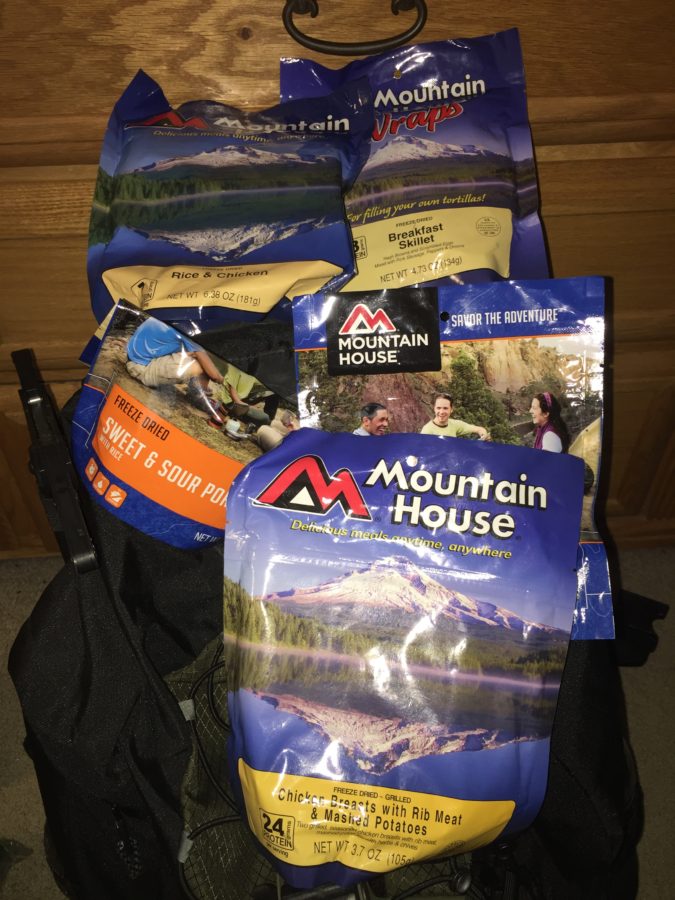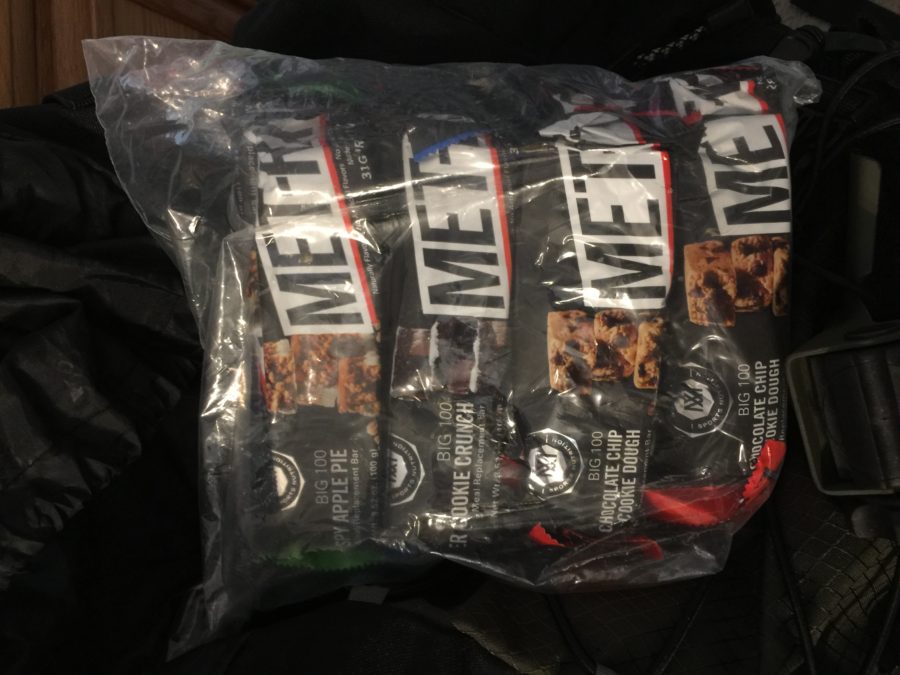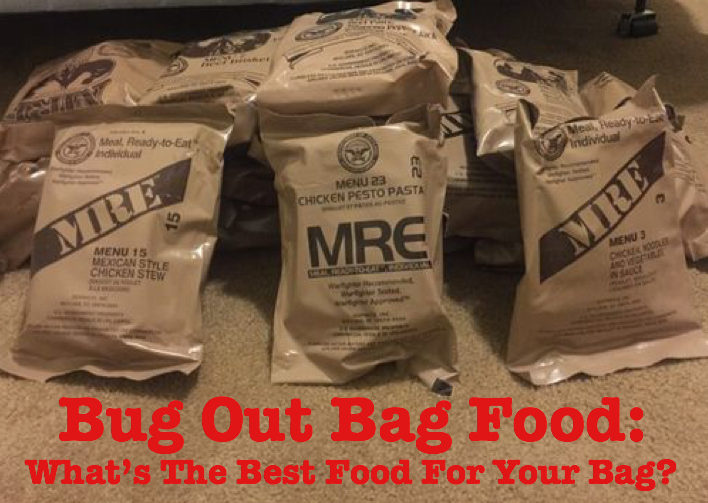There are many factors that you need to take into consideration when choosing the right food for your Bug Out Bag and Bug Out Kit. You obviously need the right number of calories to get you where you are going but there is more to it than that.
- How Many Calories Do You Need?
- Do You Have Special Dietary Needs?
- How Much Weight Can You Handle?
- How Much Space Do You Have?
- How Often Do You Want to Rotate Out Your Food?
These are all questions that you need to ask yourself before you get into packing your bug out bag.
The survival rule of three’s says you can go for three weeks without food and this is true for most people but there is a difference between surviving and being able to perform effectively. During a bug out situation, you will need to be able to perform at your very best, just surviving is not the goal.
How Many Calories Do You Need?
So, how many calories do you need for your bug out bag? There are several factors that you need to consider. The first thing is to figure out how many calories you need per day and then how many days your bug out plan will take to execute and then add a little extra, just in case.
The number of calories someone needs will vary depending on gender, age, and activity level. For bugging out we will assume the activity level will be on the most Active end of the scale. This is a condensed chart I made, for the complete chart, check it out here at WebMD.
| Gender | Age | Calories Per Day |
| Child | 2-3 | 1000-1400 |
| Female | 4-13 14-50 50+ | 1400-2200 2400 2000-2200 |
| Male | 4-13 14-50+ | 1600-2600 2800-3200 |
These numbers are good estimates but everyone is different, your mileage may vary. Just remember the harder you push yourself the more calories you will burn. More than likely you will need more than what’s listed above but it’s a good starting point if you have no idea where to begin.
The survival needs hierarchy goes as follows; Air, Shelter, Water, and then Food. Food is really at the end of the list. Food is at the bottom of the list, primarily because our bodies keep some reserves. During the first 24-48 hours without food, your body will go into a “survival mode” like condition. During this time your overall physical performance won’t be degraded. In fact, some may actually experience heighten awareness and energy but after that, you will experience a significant decrease in physical and mental performance.
Do You Have Special Dietary Needs?
The next question, do you have any special dietary requirements? Are you diabetic, gluten intolerant, or have certain food allergies. Having any of these will definitely affect what can pack in your bag. During your bug out is not the time to gamble with what your body can handle. Make sure that you have tried all of the different foods that you have in your bug out bag, to ensure that your body agrees with it.
How Much Weight Can You Handle?
There are many factors that affect the overall weight of your bug out bag. The food choices you make can greatly affect the weight of your bug out bag. Foods that are lightweight generally require more preparation and foods that require less preparation are usually heavier. There’s always going to be, give and take.
Many times the weight of your food’s packaging can be unnecessarily heavy, like in the case of canned foods. The weight of metal cans makes most canned food a no go. There are alternatives if you really want to have some canned meats, you can now get them in packets instead of cans.
QUICK TIP: As long as you don’t have a peanut allergy, peanut butter is one of the most calorie dense foods by weight. Peanut butter has 170-190 calories per ounce, depending on brand and type, which equates to about 2,880 calories in a one pound jar. Four pounds of peanut butter would net you about 3,840 a day for 3 days. To put it in perspective, just one day of MRE’s weighs about 4-1/2 pounds.
A few examples of food choices and weight per day’s Calories.
| 1 Day (3600-3800 Cal.) | Approximate Weight in Pounds |
| MRE’s (3) | 4.5# |
| Meal/Protein Bars (9 Bars) | 2.0# |
| SOS/Life Boat Rations | 1.6# |
| Freeze-dried Meals | 2.4# |
| Peanut Butter (20 oz.) | 1.25# |
How Much Space Do You Have?
Another limitation on how much food you can carry is the space you have available. Large and bulky food can use up a lot of space in your pack that you may need for other items. This is where choosing the right pack can make all the difference. I talk about choosing the right bug out bag in an article I wrote: How To Build A Bug Out Bag/Kit: A Practical Guide
How Often Do You Want to Rotate Out Your Food?
All foods have a shelf life, some longer than others. One of the main things with bug out bags is you want to get it set up and then forget about it until you need it, you don’t want to be removing gear from your bag but water and most foods will need to be rotated out from time to time.
I like to keep foods like meal replacement bars at the top of my bag or in external pockets for ease of access during a bug out but also so I can easily rotate it out. I like to rotate out these foods in the fall and spring.
Common Bug Out Bag Food Options
Most people that have had a bug out bag for much time will have tested out their gear and food options, and have learned what works best for them. When you are just getting started it may seem a little overwhelming, some food options may be better choices than others, to get you started.
Freeze-dried Meals
There are tons of manufacturers making freeze-dried food for long term storage. Some of the top companies like Wise, Moutain House, and Patriot Pantry make quality freeze-dried long shelf life foods

The only problem with choosing freeze-dried foods for your bug out bag is that you will want to have a way of boiling water. If you planned your bug out bag well you should have at least some way of starting a fire and something to boil water in or you packed a mini stove.
SHELF LIFE – 25+ Years
PROS
- Very long shelf life
- Has high nutritional value
- Generally, have great taste and texture
CONS
- More difficult for beginners to work with, mixing and matching meals to get the right calorie counts
- Requires water to prepare, For best results requires hot water
- The packaging is often awkward to pack
- Takes up a lot of space in your pack
MRE’s
MRE’s or Meals Ready to Eat are produced by both military and civilian sources. These require no extras to ready them for consumption.
SHELF LIFE – 3.5 Years @80 deg.F Less when hotter and more when cooler.
PROS
- Includes Many Extras, including Utensils, Candy and gum, Beverage mixes and seasonings, Toilet paper Plus more.
- Does not require any cooking or water to prepare
- Many come with a heater
- Available with many different meal selections
CONS
- Heavy and takes up a lot of space, because of all of the extras and the fact that it does not require reconstituting it is much heavier than freeze-dried meals. The average complete MRE weighs about 1.5 pounds but can be stripped down to weigh less.
- Taste can be debated, some will think they taste fine others not so much.
Meal Replacement Bars

Meal replacement bars are great for eating on the go, require no preparation just open and eat. Quality meal replacement bars have a good mix of carbs, protein, and fats to keep you going.
SHELF LIFE – 6-M
PROS
- Quick and easy, great for refueling on the go
- Generally, taste good
CONS
- Short shelf life when compared to other options, will require more frequent rotation.
- Thirst invoking, you will need to have a drink after eating one
Emergency Rations (Life Boat Rations)
These types of rations are really made for sedentary survival. Most of the 3600 calorie packages are said to be 3 day/72 hour supplies, in my book that is a 1 day supply.
SHELF LIFE – 5 Years
PROS
- Long shelf life
- Lightweight
- Non-thirst provoking
- Easy to ration squares
CONS
- Not the best nutritional option
- Not very appetizing
My Bug Out Bag Foods and Why I Chose Them
In my bug out bag, I prefer to diversify my food selection. My bug out plan does not have me traveling more than 2 days but I always use 3 days (72 Hours) as a minimum. My plan is to keep moving as fast a possible during the daylight hours and stop only as long as necessary, then in the evening set up a campsite and have a solid meal.
This plan calls for “six” meals on the go and three sit down meals. My breakfast’s and lunches consist of a mix of meal replacement bars and emergency rations and the dinners consist of 2 full MRE’s and a mix of Moutain House meals equaling about 1200-1300 calories. This food load-out brings my total food weight to 7.5 pounds and also offers some
Final Thoughts
Although food isn’t a huge priority for short term bug out situations, you will be glad that you packed some fuel for your body and your soul. Warm and tasty food can be a great morale booster. It’s good to have a variety of foods but also to keep it simple.


